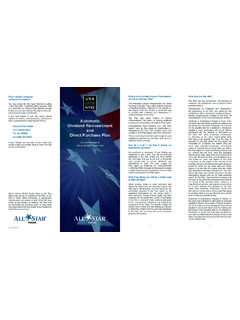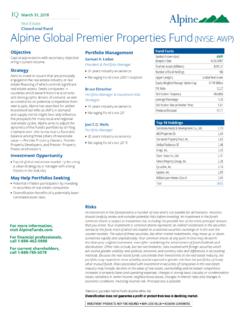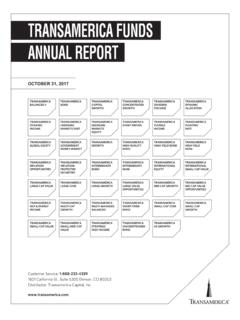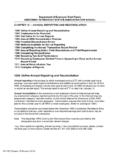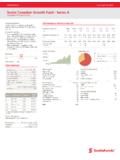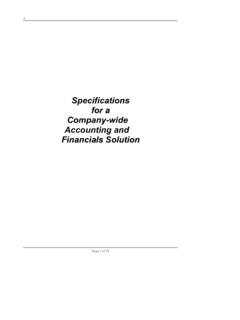Transcription of Understanding the Advantages of Closed-End Funds
1 Understanding the Advantages of Closed-End Funds Table of Contents Introduction ..1. Exchange Traded Advantages ..5. Investment Types of Closed-End Funds ..13. Buying and Selling ..16. Net Asset Value ..18. Dividends and Distributions ..19. Performance ..20. Discounts and Sources of Frequently Asked Closed-End fund Association ..31. 2006 Closed-End fund Association, Inc. All rights reserved. A World of Introduction Investment Opportunity Closed-End Funds (CEFs) are professionally managed investment companies that offer investors an array of benefits unique in the investment world. While often compared to traditional open-end mutual Funds , Closed-End Funds have many distinguishing features. Once investors They offer investors numerous ways to understand the risks generate capital growth and income through associated with Closed-End fund portfolio performance, dividends and investing, they also distributions, and through trades in the understand the marketplace at beneficial prices.
2 Opportunities to CEF shares are listed on securities achieve superior exchanges and bought and sold in the open performance. market. They typically trade in relation to, but independent of, their underlying net asset values (NAVs). Intra-day trading allows investors to purchase and sell shares of Closed-End Funds just like the shares of other publicly traded securities. In addition, when shares of Closed-End Funds trade at prices below their underlying NAVs (at a discount), investors have the opportunity to enhance the return on their investment by making bargain purchases. 1. The history of Closed-End Funds began in 1893, more than 30 years before the first mutual fund was formed in the United States. Currently, there are more than 650 Closed-End Funds , some of which have management and There are two performance histories that date back over types of investment half a century.
3 Many investors hold CEFs for companies, long periods of time, and it is not unusual open-end and for shares to be handed down from one Closed-End . generation to the next. Closed-End Funds are truly unique investments and provide investors an important way to achieve their long-term investment goals. Investment Company Industry Investment companies have been around for over 100 years; however, the foundation for their current popularity was laid with the passage of the Investment Company Act of 1940 (the 1940 Act). This legislation and subsequent amendments and related rules have provided the blueprint for millions of individual investors to obtain professional management of a diversified portfolio of securities at a reasonable cost. There are two principal types of investment companies: open-end and Closed-End . 2. What is a Open-end Funds (more commonly known Closed-End as mutual Funds ) continuously offer their fund ?
4 Shares to investors and prospective investors and stand ready to redeem their shares at all times. Transactions in shares of mutual Funds are based on their net asset value (NAV), determined at the close of each business day. The capital structure Sometimes the transaction price includes an and number of adjustment for a sales, redemption or other shares are fixed, charge. NAV is the value of the fund 's assets hence the term less its liabilities divided by the number of Closed-End . the fund 's outstanding shares. The invested capital in a mutual fund tends to fluctuate based on investor sentiment. Closed-End Funds have a fixed number of shares outstanding. Following an initial public offering, their shares are traded on an exchange between investors. Transactions in shares of Closed-End Funds are based on their market price as determined by the forces of supply and demand among investors in the marketplace.
5 Interestingly, the price of a CEF may be above (at a premium to) or below (at a discount to) its NAV. The transaction price will also include a customary brokerage charge. The invested capital in a closed - end fund is fixed and will change only at the direction of management. Capital can be increased through the issuance of shares in conjunction with a rights offering or through the reinvestment of certain fund dividends and distributions. Capital can be reduced when shares of the fund are repurchased in conjunction with a 3 stock repurchase program or tender offer. How Do Exchange Traded Funds (ETFs) Fit into the Picture? Exchange traded Funds commonly referred to as ETFs share some characteristics ETFs generally are with Closed-End Funds . In fact, Closed-End passive investment Funds are often described as a type of ETF. vehicles whereas Like Closed-End Funds , ETFs trade on most Closed-End exchanges, are continuously priced throughout Funds are actively the trading day and their market price is determined managed.
6 By supply and demand. Both allow the investor to utilize different types of trading strategies, such as short selling, buying on margin and limit orders. Perhaps the biggest difference is that ETFs generally are passive investment vehicles designed to closely track the performance of an index or other benchmark, whereas most Closed-End Funds are actively managed. Actively managed Funds are those in which the investment manager makes portfolio decisions with the objective of outperforming, not just tracking, an appropriate index or benchmark. Because of their structure, ETFs tend to closely track the value of the underlying securities in their portfolios while Closed-End Funds tend to trade at either discounts or premiums to the underlying value of the assets in the fund . ETF's are relatively new investment vehicles. The first ETF opened for trading on the American Stock Exchange in 1993 100 years after the advent of the first Closed-End fund .
7 Today, there are hundreds of listed ETFs representing several hundred billion dollars in assets. 4. Advantages of Funds If you have had experience with mutual If you have had Funds , many Advantages of Closed-End Funds experience with should be familiar to you. Let's cover those mutual Funds , first. Then, we'll identify a few benefits of many of the Advantages of Closed-End fund investing which aren't Closed-End Funds available in mutual Funds . should be Diversification In Closed-End Funds , you familiar to you. participate in a portfolio that invests in many securities, and this helps to spread market risk. If any one security performs poorly, it shouldn't have a severe impact on your investment. Professional Management The portfolio manager or team selects securities and monitors them on a full-time basis. You can participate in Closed-End Funds without developing investment expertise or devoting hours of time to research on specific issues.
8 Clear Objectives Most Closed-End Funds specialize in either stocks or fixed-income securities and pursue a consistent objective, such as capital appreciation or current income. Some Funds are highly specialized, investing in a given region, country or specific type of security. You can select Funds with management styles and objectives that match your needs. Convenience You may buy or sell shares quickly and easily during the day in any quantity that your brokerage firm permits. 5. Liquidity Whether your order is to buy or sell a few shares or several thousand, you should be able to execute your trade in active and competitive bidding. Economy of Scale The costs of operating a Closed-End fund are divided pro rata among all shareholders. The major ongoing cost, a management fee paid to the investment advisor, is based on assets and is very competitive with the same expense in mutual Funds .
9 Periodic Distributions Your fund will make distributions according to a prescribed schedule. If you depend on your investments for current income, this will allow you to plan the timing of income. (The actual amounts of income distributed by Closed-End Funds vary with market conditions and fund performance.). Pass Through Taxation Like mutual Funds , Closed-End Funds generally do not pay tax at the fund level on amounts distributed to investors. The taxation is said to pass through to the shareholders. Available for Many Accounts Like mutual Funds , Closed-End Funds may be purchased in regular brokerage accounts (individual or joint-name), retirement plan accounts, trust accounts or custodial accounts. 6. Advantages of CEFs Opportunity to Buy at a Discount . When Closed-End Funds can be bought at a ..now add the discount to net asset value, investors are buying Advantages of CEFs a dollar's worth of assets for less than a dollar.
10 Which aren't found This can be attractive for two reasons: in mutual Funds : In income-oriented Funds , the yield will be higher when calculated on actual dollars -Opportunity to buy invested at a discount, compared to NAV. at a discount. To take an example, suppose a fund has a NAV of $20 per share, market price of $18 a share, and generates income of $1 per year. -Efficient portfolio The yield based on NAV is 5% ($1 divided management. by $20). If you bought a mutual fund at NAV, this is the yield you would receive. But in the Closed-End fund , the yield based on actual -Ability to control dollars invested is ($1 divided by $18). market price and timing. If, during the holding period of your closed - end fund , the discount to NAV narrows, the reduction in the discount will give a boost -Leverage potential. to the fund 's performance when you sell the shares.
